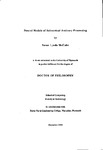Neural Models of Subcortical Auditory Processing
| dc.contributor.author | McCabe, Susan Lynda | |
| dc.contributor.other | School of Engineering, Computing and Mathematics | en_US |
| dc.date.accessioned | 2013-10-11T09:25:24Z | |
| dc.date.available | 2013-10-11T09:25:24Z | |
| dc.date.issued | 1994 | |
| dc.identifier | NOT AVAILABLE | en_US |
| dc.identifier.uri | http://hdl.handle.net/10026.1/2167 | |
| dc.description.abstract |
An important feature of the auditory system is its ability to distinguish many simultaneous sound sources. The primary goal of this work was to understand how a robust, preattentive analysis of the auditory scene is accomplished by the subcortical auditory system. Reasonably accurate modelling of the morphology and organisation of the relevant auditory nuclei, was seen as being of great importance. The formulation of plausible models and their subsequent simulation was found to be invaluable in elucidating biological processes and in highlighting areas of uncertainty. In the thesis, a review of important aspects of mammalian auditory processing is presented and used as a basis for the subsequent modelling work. For each aspect of auditory processing modelled, psychophysical results are described and existing models reviewed, before the models used here are described and simulated. Auditory processes which are modelled include the peripheral system, and the production of tonotopic maps of the spectral content of complex acoustic stimuli, and of modulation frequency or periodicity. A model of the formation of sequential associations between successive sounds is described, and the model is shown to be capable of emulating a wide range of psychophysical behaviour. The grouping of related spectral components and the development of pitch perception is also investigated. Finally a critical assessment of the work and ideas for future developments are presented. The principal contributions of this work are the further development of a model for pitch perception and the development of a novel architecture for the sequential association of those groups. In the process of developing these ideas, further insights into subcortical auditory processing were gained, and explanations for a number of puzzling psychophysical characteristics suggested. | en_US |
| dc.description.sponsorship | Royal Naval Engineering College, Manadon, Plymouth | en_US |
| dc.language.iso | en | en_US |
| dc.publisher | University of Plymouth | en_US |
| dc.title | Neural Models of Subcortical Auditory Processing | en_US |
| dc.type | Thesis | |
| dc.identifier.doi | http://dx.doi.org/10.24382/1466 | |
| dc.identifier.doi | http://dx.doi.org/10.24382/1466 |
Files in this item
This item appears in the following Collection(s)
-
01 Research Theses Main Collection
Research Theses Main


